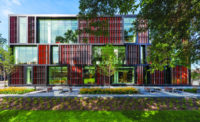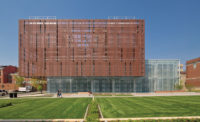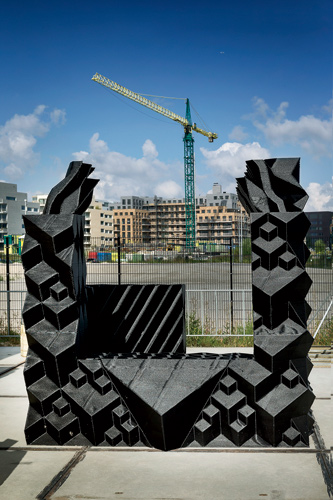The Fine Print
Three design teams employ three different methods to arrive at 3-D printed structures.

The Fine Print
When complete, DUS Architects’ canal house will resemble a traditional Dutch home.
Image courtesy DUS Architects

The Fine Print
The firm has encouraged the public's involvement, inviting visitors to see the printer in action.
Image courtesy Architectural Record

The Fine Print
The house is printed piece by piece. A chunk of one room features an intricate tessellation-like pattern.
Photo © Olivier Middendorp

The Fine Print
The house is printed piece by piece. A chunk of one room features an intricate tessellation-like pattern.
Image courtesy DUS Architects

The Fine Print
A team at UC Berkeley unveiled the world's first freestanding powder-printed cement 3-D structure.
Photo © Matthew Millman

The Fine Print
The pavilion, called Bloom, is made up of 840 individual bricks, which form a lacy floral pattern when joined together.
Photo © Matthew Millman

The Fine Print
The pavilion is 9 feet tall and has a footprint of 144 square feet.
Photo © Matthew Millman







The firm has encouraged the public’s involvement, inviting visitors to see the printer in action. The house is printed piece by piece. A chunk of one room features an intricate tessellation-like pattern.
In the summer of 1908, Thomas Edison filed a patent for a contraption that could construct a house—bathtubs and all—with a single pour of concrete. Although such aspirations may seem amusing today, Edison's goals aren't far off those of contemporary research involving the 3-D printer. Three ongoing architecture projects on three continents demonstrate different approaches to this technology. If successful, they will have far-reaching implications for the design and construction industry.
Perhaps the most prominent example is the 3D Print Canal House, a project started by Amsterdam-based firm DUS Architects in January 2014 and funded, in part, by the city. Using a beefed-up version of an Ultimaker desktop 3-D printer (the Kamermaker, as it's called, is approximately 20 feet tall), the firm is printing large architectural components of the house with a bio-based “ink” made primarily of linseed oil. When completed, these components—which have openings for wire and cables—will be filled with a lightweight concrete to connect them. To date, they have printed one room, and, this month, DUS plans to unveil a second machine that will print even larger pieces and enable the team to print 24 hours a day.
“As a firm, our dream is that people can go online, download their ideal house, and customize it on demand with no hassle, so that the luxury of made-to-measure architecture becomes available to the masses,” says DUS partner Hedwig Heinsman.
Since DUS began the project in earnest barely a year ago, the architects say they have increased the printer speed by 400 percent. Currently, the team is experimenting with the molecular makeup of the ink and incorporating additives such as wood chips, which creates a product similar to particleboard. They are also printing molds and testing the tensile properties of the house's components.
Meanwhile, 5,500 miles away in Shanghai, WinSun Decoration Design Engineering is taking DUS's utopian ideal to an extreme. Last summer, Computer World reported that the company can print 10 squat one-room houses in 24 hours from a mix that includes construction debris. This printer is a whopping 20 feet tall, 33 feet wide and 132 feet long. In January, with an even larger printer, they fabricated a five-story apartment building and a neoclassical mansion. WinSun could not be reached for comment.
Unlike the Chinese and Dutch projects, a research team at the University of California, Berkeley, is developing small 3-D printed tile-like “bricks” to build rooms and other small structures. In March, the team unveiled Bloom, a lacy 9-foot-tall pavilion made from a specially developed polymer of Portland cement, vegetable oil, and sawdust. Composed of 840 individual bricks, each assigned a number and bound together with stainless-steel fasteners, the pavilion can easily be dismantled and reassembled. After the pavilion's stint at Berkeley, it will be displayed in Thailand at the headquarters of Siam Cement Group (SCG), the company that sponsored the project.
The team is working to push their product to market. With the studio's 11 printers, they can make approximately 30 bricks daily, but, unlike the Chinese firm's, this team's objective is not necessarily speed or increasingly large printed components—instead they see value in the resolution and craftsmanship that smaller pieces afford.
“Other companies are making architectural-sized machines with the assumption that architectural-sized machines will produce architecture,” says Ronald Rael, the associate professor who led the Berkeley project. “There's a lot of craft in this. It's not simply that the robot is doing all the work.”
| Video courtesy DUS Architects |
| The Kamermaker in action printing a portion of DUS Architects' 3D Print Canal House. |












